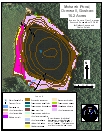Mohawk Pond, Cornwall
2005 Aquatic Plant Survey Map of Mohawk Pond
Mohawk Pond exists entirely within the forested Mohawk State Park. The state maintains a boat launch on the southern shore. The only development on the pond is a children’s camp at the northwest end. The pond has a maximum depth of 26 feet (8 m) and a mean depth of 15 feet (4.5 m).
Mohawk Pond has a broad shallow shelf around its edges that support abundant growth of floating-leaved and submerged species. The most abundant of these species, during our September 2005 survey, was purple bladderwort (Utricularia purpurea), which formed an almost continuous band around the pond, from the shore to depths of 12 feet (3.5 m). White water lily (Nymphaea odorata) was also abundant, particularly on the west side of the pond. Similarly, floating-leaf pondweed (Potamogeton natans) occurred on all sides of the pond, but in much smaller patches.
Other species were found to a lesser extent including large-leaf pondweed (Potamogeton amplifolius), arrowhead (Sagittaria species), and floating bladderwort (Utricularia radiata) on the north, south, and east sides, and yellow water lily (Nuphar variegata) on the north, south, and west sides. Ribbon-Leaf pondweed (Potamogeton epihydrus) was found on the west, east, and south sides, and watershield (Brasenia schreberi) was found on the west, east, and north sides of the pond. Snailseed pondweed (Potamogeton bicupulatus) was found on the north and south sides, and sevenangle pipewort (Eriocaulon aquaticum) was found only on the south side of Mohawk Pond. Common bladderwort (Utricularia macrorhiza), humped bladderwort (Utricularia gibba), western waterweed (Elodea nuttallii), thread-leaf naiad (Najas gracillima), flat-leaf bladderwort (Utricularia intermedia), and a sedge (Carex) grew only on the north edge of the pond.


